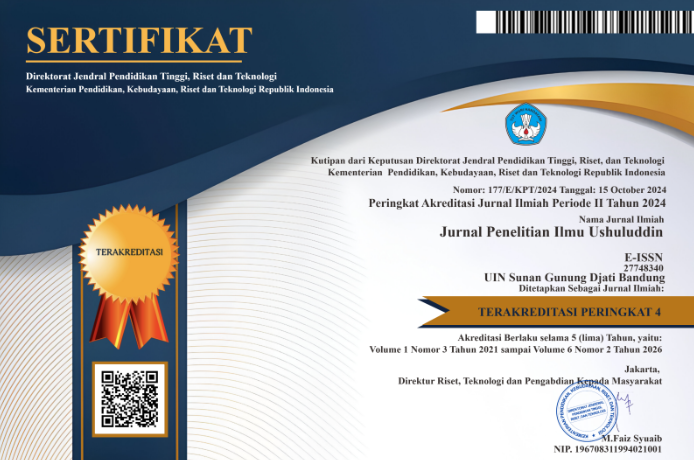Relasi Intelektualitas dan Spiritualitas Perspektif Tarekat Naqsabandiyah Khalidiyah
DOI:
https://doi.org/10.15575/jpiu.43497Keywords:
Intellectuality, Naqsabandiyah Khalidiyah, Spirituality, TariqahAbstract
The integration between intellectuality and spirituality in Sufism is very necessary because it can produce self-actualization for followers of tarekat, so that human behavior will reflect divine traits in their daily lives. This study aims to examine the relationship between intellectuality and spirituality which then has an impact on the morality of the congregation of the Naqsabandiyah Khalidiyah tariqah perspective. This research uses a qualitative method conducted at the Prof. Dr. Kadirun Yahya Foundation located on Jenderal Gatot Subroto Street KM 4.5 Sei Siskamling Medan, North Sumatra. This study found that in the study of Naqsabandiyah Khalidiyah tarekat pioneered by Shaykh Kadirun Yahya, self-actualization or ihsan behavior in Sufism can be obtained through a process of integration between intellectual and spiritual potential. This is done because every congregation of the congregation must have an understanding and ability to explain the scientific concepts of the implementation of spiritual rituals performed. The scientific tradition built by Sheikh Kadirun Yahya in Tarekat Naqsabandiyah Khalidiyah is intended to encourage the intellectual potential of the congregation, considering that theories related to general sciences such as natural science, physics, and chemistry are growing rapidly. Meanwhile, religious sciences seem to have developed rapidly, but have stagnated due to religious teachings that are adhered to traditionally and dogmatically. Future research is expected to further analyze the contribution of Shaykh Kadirun Yahya's thought to the renewal of the Sufism tradition in a modern context, especially amid the challenges of globalization and secularization.References
Adz-Dzaky, M. H. B. (2002). Konseling & psikoterapi Islam: penerapan metode sufistik. Fajar Pustaka Baru. https://books.google.co.id/books?id=XFNmAAAACAAJ
Aini, P. F., & Rosyad, R. (2019). Khalwat dalam mengendalikan emosi. Syifa Al-Qulub, 3(2), 53–64.
Al-Anshary, A. F. (2019). Rukyah Bil Qalbi Perspektif Tarekat Naqsabandiyah Khalidiyah Al-Aliyah Jombang. ELFALAKY: Jurnal Ilmu Falak, 3(1).
Annajih, M. Z. H., & Sa’idah, I. (2023). Konsep Self-actualized Abraham Maslow: Perspektif Psikologi Sufistik. Edu Consilium: Jurnal Bimbingan Dan Konseling Pendidikan Islam, 4(1), 43–52.
Arraiyah, H. (2018). Kehidupan Penganut Tarekat Naqsyabandiyah Khalidiyah Di Pati, Jawa Tengah. Al-Qalam, 5(1), 64–71.
Baron, R., & Byrne, D. (2002). PsicologÃa Social. Prentice Hall. https://books.google.co.id/books?id=wina0AEACAAJ
Budi, P. (1961). Mencetak Generasi Unggul dan Religius. https://www.pancabudi.ac.id/pages/pagesdetail/about
Calicchio, S. (2023). Abraham Maslow, dari hierarki kebutuhan hingga pemenuhan diri: Sebuah perjalanan dalam psikologi humanistik melalui hierarki kebutuhan, motivasi, dan pencapaian potensi manusia sepenuhnya. Stefano Calicchio. https://books.google.co.id/books?id=SILqEAAAQBAJ
Chaplin, J. P., & Kartono, K. (1989). Kamus lengkap psikologi. Rajawali Pers. https://books.google.co.id/books?id=1p67AQAACAAJ
Dahlan, Z. (2020). Ulama Tasawuf Di Sumatera Timur Abad Xix Dan Xx: Menyingkap Jejak Tradisi Intelektual Syekh h. Abdul Wahab Rokan (1811-1926) Dan Prof. Dr. H. Saidi Syekh Kadirun Yahya (1917-2001). ANSIRU PAI: Pengembangan Profesi Guru Pendidikan Agama Islam, 4(2), 1–25.
Faiz, M. (2013). Integrasi Nilai Spiritual, Intelektual dan Moral Dalam Konsep Pendidikan Said Nursi. Ar-Risalah, Vol. XI(1).
Fakhriati, F. (2013). Kadirun Yahya: Perjalanan Menuju Saidi Syekh dalam Tarekat Naqsyabandiyah Kholidiyah. Jurnal Lektur Keagamaan, 11(1), 237–260.
Fauzi, R. (2008). Tarekat Naqsabandiyah Khalidiyah Di Slemanan Kabupaten Blitar. Analisa Journal of Social Science and Religion, 15(01), 33–50.
Faza, A. M. D. (2019). Tasawuf falsafi. Al-Hikmah: Jurnal Theosofi Dan Peradaban Islam, 1(1).
Hornby, A. S., Gatenby, E. V, & Wakefield, H. (1961). The Advanced Learner’s Dictionary of Current English. Oxford University Press. https://books.google.co.id/books?id=LFE7uAAACAAJ
Ilyas, A. F. (2017). Syekh Ahmad Khatib Minangkabau Dan Polemik Tarekat Naqsyabandiyah Di Nusantara. Journal of Contemporary Islam and Muslim Societies, 1(1), 86–112.
Ir Syarifuddin, M. H., Kamil, M., & Sakban Lubis, S. H. I. (2022). Tariqat Dalam Tasawuf. Merdeka Kreasi Group.
Kamba, M. N. (2020). Mencintai Allah Secara Merdeka. Iiman Real. https://books.google.co.id/books?id=cnwD0AEACAAJ
Kamba, M. N. (2022). Kids zaman now: menemukan kembali Islam. Pustaka IIMaN. https://books.google.co.id/books?id=9YzixgEACAAJ
Lubis, S. (2018). Tharekat Naqsabandiyah Kholidiyah Saidi Syekh Prof. Dr. H. Kadirun Yahya, MA di Universitas Pembangunan Panca Budi Medan. Almufida: Jurnal Ilmu-Ilmu Keislaman, 3(1).
Mannan, A. (2018). Esensi Tasawuf Akhlaki di Era Modernisasi. Aqidah-Ta: Jurnal Ilmu Aqidah, 4(1), 36–56.
Purnamasari, N. I. (2018). Tasawuf ‘Amali Sebagai Model Tasawuf Sosial. Mukammil: Jurnal Kajian Keislaman, 1(2), 168–193.
Saihu, M. (2022). KONTEKSTUALISASI PEMIKIRAN PENDIDIKAN IBNU SINA DI ERA KONTEMPORER. Andragogi: Jurnal Pendidikan Islam Dan Manajemen Pendidikan Islam, 3(2). https://doi.org/10.36671/andragogi.v3i2.227
Shihab, A. (1999). Islam Inklusif: Menuju Sikap terbuka dalam beragama. Mizan.
Sudarmaji, A. K. (2018). Tarekat Naqsyabandiyah Khalidiyah Dan Eksistensinya Di Plosokuning Tahun 1954-1995. Ilmu Sejarah-S1, 3(2).
Sugiarto, E. (2017). Menyusun Proposal Penelitian Kualitatif: Skripsi dan Tesis: Suaka Media. Diandra Kreatif.
Sugiyono. (2015). Metode Penelitian Kuantitatif, Kualitatif, Dan R&D. Alfabeta.
Syarifuddin. (2024). Wawancara Dengan Mursyid Tarekat Naqsabandiyah Khalidiyah.
Theodorson, G. A., Theodorson, A. G., & Theodorson, A. A. (1979). A Modern Dictionary of Sociology. Barnes & Noble Books. https://books.google.co.id/books?id=lfmBmHlw9isC
Van Bruinessen, M. (1992). Tarekat Naqsyabandiyah di Indonesia. Mizan.
Yahya, K. (2022a). Metafisika Eksakta. Fekon UNPAB Press.
Yahya, K. (2022b). Metafisika Tasawuf dalam Islam. Fekon UNPAB Press.
Yahya, K. (2022). Metafisika Teknologi Dalam Islam. Fekon UNPAB Press.
Yusuf, S. M. (2020). Inter-subjectivity of khalwat (suluk) members in the tarekat Naqsyabandiyah Khalidiyah Ponorogo. Indonesian Journal of Islam and Muslim Societies, 10(1), 103–126.
Zuhri, M. (1976). Kunci Memahami Ilmu Tasawuf. PT Bina Ilmu.
Downloads
Published
Issue
Section
License
Authors who publish in Jurnal Penelitian Ilmu Ushuluddin agree to the following terms:
- Authors retain copyright and grant the journal right of first publication with the work simultaneously licensed under an Attribution-ShareAlike 4.0 International (CC BY-SA 4.0) License that allows others to share the work with an acknowledgment of the work's authorship and initial publication in this journal.
- Authors are able to enter into separate, additional contractual arrangements for the non-exclusive distribution of the journal's published version of the work (e.g., post it to an institutional repository or publish it in a book), with an acknowledgment of its initial publication in this journal.
- Authors are permitted and encouraged to post their work online (e.g., in institutional repositories or on their website) prior to and during the submission process, as it can lead to productive exchanges, as well as earlier and greater citation of published work (See The Effect of Open Access).












